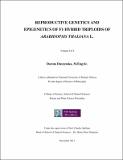| dc.description.abstract | Polyploidy, the occurrence of more than two complete sets of chromosomes in a single nucleus, is an important process contributing to eukaryotic evolution. Polyploidy is also a widespread speciation mechanism and is common among plants, fish and amphibians. Polyploidy can be advantageous, and lead to heterosis, gene redundancy, and asexual reproduction (apomixis). However, polyploidy makes the completion of mitosis and meiosis more challenging, which often results in production of aneuploid cells and gametes. Improved understanding of the biology of polyploids is essential because many economically important crops are polyploid, including Solanum tuberosum (potato), Triticum (wheat) and Gossypium (cotton).
Polyploid crops also include triploid crops such as Musa (banana), Malus domestica (apple) and Beta vulgaris (sugar beet). Chromosome segregation during triploid meiosis is particularly complicated by the need for the three sets of chromosomes to be resolved to two poles which results in the production of gametes with frequent chromosome loss and fragmentation. Hence, the immediate progeny of triploids can have complex karyotypes, which can differ in the number of copies of each chromosome. Imbalanced dosage effects resulting from aneuploidy can be deleterious to development, and contribute to the dramatic reduction in fertility of triploids.
In this thesis, genome dosage and hybridity effects on reproduction, seed size heterosis and seed development were investigated using a set of F1 hybrid and isogenic triploids of Arabidopsis thaliana. These were generated by reciprocal inter-ploidy crosses, incorporating 90 different accessions that can differ genetically and epigenetically. Relative triploid reproductive traits of selfed F1 triploids were analysed by collecting ANU data (A aborted F2 seeds, N normal F2 seeds, U- unfertilized ovules) and by converting the datasets to %A, %N, %U with respect to the total number of ovules per silique (E = A+N+U).
It was discovered that, depending on genotype, selfed F1 isogenic triploids and F1 hybrid triploids exhibit differing levels of fertility defects at the pre-fertilisation (unfertilised F1 ovules) and post-fertilisation stages (normal vs aborted F2 seeds). It was further discovered that epigenetic parent-of-origin effects on reproduction and seed development can occur between reciprocal F1 triploids which have differing contributions of maternal- vs paternal-derived chromosomes. Such epigenetic parent-of-origin effects were observed for both isogenic F1 triploids (Col-0) and for a wide range of hybrid F1 triploid genotypes. The epigenetic parent-of-origin effects either caused greater fertility defects in the maternal excess F1 triploid or in the paternal excess F1 triploid. Flow cytometric analysis of single seed indicated that the surviving F2 seed progeny comprised a wide range of DNA contents, including likely aneuploids with incomplete sets of chromosomes. This supports the proposed role for triploids as evolutionary bridges between plant populations of different ploidy levels.
The 89 diploid accessions used to generate the F1 hybrid triploids have been extensively characterised for SNPs (Single Nucleotide Polymorphisms) across the Arabidopsis thaliana genome. This allowed the use of genome wide association (GWA) mapping for the identification of loci involved in control of reciprocal F1 hybrid triploid reproduction and production of normal F2 seed sets (%N). Two candidate loci involved in the phenotypic variation in %N among F2 seeds produced by paternal excess F1 triploids and maternal excess F1 triploids were identified by GWA mapping and named POT (Paternal Overdose Triploid) and MOT (Maternal Overdose Triploid) respectively. Candidate protein-coding genes at the POT and MOT loci were selected based on their known involvement in the plant reproductive pathways and seed development. Some of these genes are involved in epigenetic processes including DNA methylation, histone modification, and siRNA mediated gene silencing and are strong candidates for explaining the epigenetic parent-of-origin effects which are controlling triploid reproductive success. | en_US |


